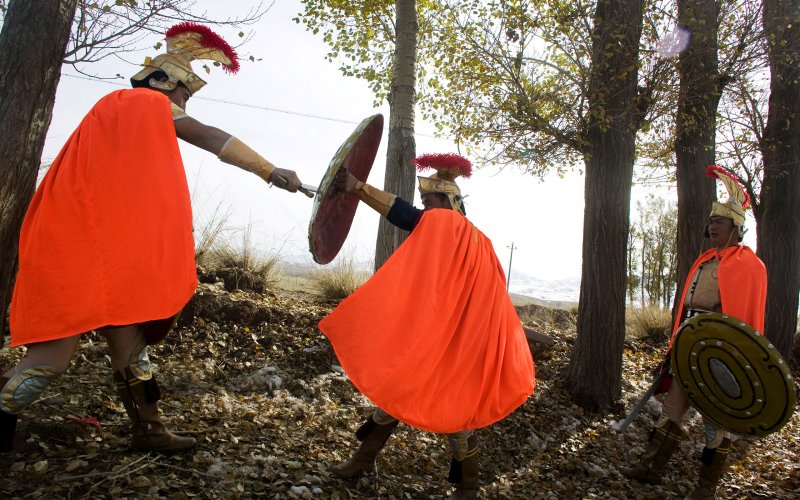In a remote corner of China, one village tells a strange lineage tale. The story (and some DNA evidence) goes, the locals are the descendants of a band of Roman soldiers from 36 B.C.
In a tiny, remote Chinese village, an ancient Roman bloodline may live on. The town of Liqian sits on the edge of the Gobi desert, 200 miles from any metropolis, and 4,500 miles from Rome. But for half a century, scientists and archaeologists have been trying to prove that the ruddy-skinned, light-eyed, and fair-haired residents of Liqian are lost relatives of a missing Roman battalion of mercenaries that fought against the Chinese long before Marco Polo started east.
The theory was first floated in the 1950s by Professor Homer Dubs of Oxford University. In a lecture to the China Society in London, he theorized that Liqian was connected to an ancient battle between the Huns and the Chinese that was fought, in part, by Roman mercenary soldiers in 36 B.C.
According to lore, 145 of these original soldiers of fortune either fled battle or were captured and settled in the area. Lending proof to this theory was a set of Chinese documents which show, 2,000 years ago, the city was renamed to mean “prisoners taken in storming a city.” Another legend claims the villagers descended from a 6,000-person army led by famed Roman General Marcus Crassus’s son that disappeared without a trace.
Dubs embarked on his investigation after discovering the name “Liqian” translated to the ancient Chinese word for Rome. His theory had little physical evidence until 1989, when archaeologists discovered ruins outside the town that prove a settlement existed at the time they suspected. Despite interest from international teams, further outside research was halted at the time due to political tensions in China following the Tiananmen Square massacres.
Years later, in 2005, scientists took advantage of a more open government to draw blood samples from 93 residents of Liqian. Testing yielded shocking results as to their genetic makeup: some villagers were found to have DNA that contained 56 percent Caucasian origins.
DNA proof isn’t enough for academics to link the townsfolk directly to a lost Roman army. Scholars argue that the Huns included Caucasians, Asians, and Mongols in their ranks, since the area was an international trading route.
“If there weren’t Romans before in Liqian, there certainly are now.”
“The county is on the Silk Road, so there were many chances for trans-national marriages,” said Yang Gongle, a professor at Beijing Normal University, to China Daily. “The ‘foreign’ origin of the Yongchang villagers, as proven by the DNA tests, does not necessarily mean they are of ancient Roman origin.”
Two years later, further tests were done, but this time to a disappointing conclusion. Roman mercenary origin could not be accepted as true according to paternal genetic variation,” the study’s authors wrote in the Journal of Human Genetics.
That hasn’t dissuaded scholars and scientists from what has become a heated debate. Soon after these results, China and Italy joined forces to open the Italian Studies Center at Lanzhou University with the intention of tracking lost Roman descendants in the region, where the 4,000-mile Silk Road once linked Asia and Europe.
“We hope to prove the legend by digging and discovering more evidence of China’s early contact with the Roman Empire,” Yuan Honggeng, head of the center, told China Daily.
One green-eyed man, nicknamed “Cai the Roman,” became an instant celebrity due to his decidedly Roman physical characteristics. He told the Telegraph that had been informed by his great-grandfather that there remained Roman tombs more than two days’ walk away. But so far, the lack of proven Roman artifacts or ruins in the town has raised suspicions.
“For it to be indisputable, one would need to find items such as Roman money or weapons that were typical of Roman legionaries,” anthropologist Maurizio Bettini, of Siena University, told La Repubblica. “Without proof of this kind, the story of the lost legions is just a legend.”
But the legends are enough proof for the town of Liqian. Before the DNA testing even began, the villagers seized on the story of their possible roots and turned it into a tourism industry. A Roman-esque pillar was erected at the town’s entrance and some entrepreneurial townsfolk don armor and replica battle wear to entertain the visitors that have begun to trickle into the remote province. These tourists, many of whom are Italian, can even stay in a Roman-style hotel. If there weren’t Romans before in Liqian, there certainly are now.

